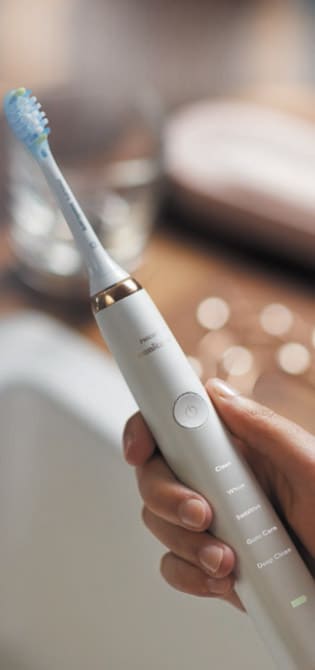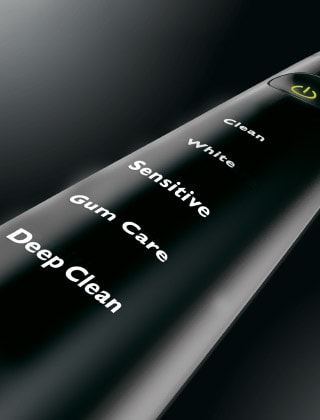
Clean Clean is your toothbrush’ workhorse mode. At 31,000 brush strokes per minute, it removes plaque with superior efficiency in a two-minute program. The Clean mode is the base setting on every Sonicare toothbrush. If you’re going to stick to one mode, make it this one. White In White mode, your toothbrush works a bit harder to remove surface stains caused by things like coffee and tea. After the standard two-minute program is completed, you’ll get an extra thirty seconds to focus on polishing your front teeth, so you get a healthy smile that really shines. Gum Health The Gum Health mode adds an extra minute of reduced power brushing to the end of the standard two-minute program. Use it to gently massage your gums for a better circulation and ultimately better gum health. Sensitive If you’ve got sensitive teeth or gums, or you just find the sonic vibrations a little overwhelming at first, switch to the Sensitive mode. In this mode, your toothbrush vibrates with lower intensity, going easier on your teeth and gums. Getting ready for a night out? Select the Polish mode for a quick one-minute touch up of your front teeth. It’s all you need to make a dazzling entrance.You snooze, you lose The snooze button may seem like the greatest invention ever for a few more minutes of much needed shut-eye. But the truth is -- it’s doing you more harm than good. That’s because your body has its own way of waking up. The process begins about two hours before you’re actually ready to wake up, and it starts with your core temperature increasing, which makes you feel less sleepy. When you’re woken up by an alarm, this process gets interrupted. While this is bad enough as it is, the moment you hit snooze, you trick your body into thinking it can go back to its dormant state. So when the alarm then goes off a second time (or let’s be honest, a third, fourth or fifth time), your body and brain are completely lost by your indecisiveness. The result is that uncomfortable groggy feeling, which can last for up to two hours into your day. So tomorrow, instead of snoozing the morning away, set your alarm for the time you actually have to get out of bed. And then get up when it goes off. Do this consistently every day and you should naturally begin to feel sleepy in the evening, because your body knows it will have to wake up X hours later. And what’s more, eventually you may be able to ditch the alarm, and rely on your natural body clock to wake you up. You snooze, you lose The snooze button may seem like the greatest invention ever for a few more minutes of much needed shut-eye. But the truth is -- it’s doing you more harm than good. That’s because your body has its own way of waking up. The process begins about two hours before you’re actually ready to wake up, and it starts with your core temperature increasing, which makes you feel less sleepy. When you’re woken up by an alarm, this process gets interrupted. While this is bad enough as it is, the moment you hit snooze, you trick your body into thinking it can go back to its dormant state. So when the alarm then goes off a second time (or let’s be honest, a third, fourth or fifth time), your body and brain are completely lost by your indecisiveness. The result is that uncomfortable groggy feeling, which can last for up to two hours into your day. So tomorrow, instead of snoozing the morning away, set your alarm for the time you actually have to get out of bed. And then get up when it goes off. Do this consistently every day and you should naturally begin to feel sleepy in the evening, because your body knows it will have to wake up X hours later. And what’s more, eventually you may be able to ditch the alarm, and rely on your natural body clock to wake you up. You snooze, you lose The snooze button may seem like the greatest invention ever for a few more minutes of much needed shut-eye. But the truth is -- it’s doing you more harm than good. That’s because your body has its own way of waking up. The process begins about two hours before you’re actually ready to wake up, and it starts with your core temperature increasing, which makes you feel less sleepy. When you’re woken up by an alarm, this process gets interrupted. While this is bad enough as it is, the moment you hit snooze, you trick your body into thinking it can go back to its dormant state. So when the alarm then goes off a second time (or let’s be honest, a third, fourth or fifth time), your body and brain are completely lost by your indecisiveness. The result is that uncomfortable groggy feeling, which can last for up to two hours into your day. So tomorrow, instead of snoozing the morning away, set your alarm for the time you actually have to get out of bed. And then get up when it goes off. Do this consistently every day and you should naturally begin to feel sleepy in the evening, because your body knows it will have to wake up X hours later. And what’s more, eventually you may be able to ditch the alarm, and rely on your natural body clock to wake you up. You snooze, you lose The snooze button may seem like the greatest invention ever for a few more minutes of much needed shut-eye. But the truth is -- it’s doing you more harm than good. That’s because your body has its own way of waking up. The process begins about two hours before you’re actually ready to wake up, and it starts with your core temperature increasing, which makes you feel less sleepy. When you’re woken up by an alarm, this process gets interrupted. While this is bad enough as it is, the moment you hit snooze, you trick your body into thinking it can go back to its dormant state. So when the alarm then goes off a second time (or let’s be honest, a third, fourth or fifth time), your body and brain are completely lost by your indecisiveness. The result is that uncomfortable groggy feeling, which can last for up to two hours into your day. So tomorrow, instead of snoozing the morning away, set your alarm for the time you actually have to get out of bed. And then get up when it goes off. Do this consistently every day and you should naturally begin to feel sleepy in the evening, because your body knows it will have to wake up X hours later. And what’s more, eventually you may be able to ditch the alarm, and rely on your natural body clock to wake you up. You snooze, you lose The snooze button may seem like the greatest invention ever for a few more minutes of much needed shut-eye. But the truth is -- it’s doing you more harm than good. That’s because your body has its own way of waking up. The process begins about two hours before you’re actually ready to wake up, and it starts with your core temperature increasing, which makes you feel less sleepy. When you’re woken up by an alarm, this process gets interrupted. While this is bad enough as it is, the moment you hit snooze, you trick your body into thinking it can go back to its dormant state. So when the alarm then goes off a second time (or let’s be honest, a third, fourth or fifth time), your body and brain are completely lost by your indecisiveness. The result is that uncomfortable groggy feeling, which can last for up to two hours into your day. So tomorrow, instead of snoozing the morning away, set your alarm for the time you actually have to get out of bed. And then get up when it goes off. Do this consistently every day and you should naturally begin to feel sleepy in the evening, because your body knows it will have to wake up X hours later. And what’s more, eventually you may be able to ditch the alarm, and rely on your natural body clock to wake you up. You snooze, you lose The snooze button may seem like the greatest invention ever for a few more minutes of much needed shut-eye. But the truth is -- it’s doing you more harm than good. That’s because your body has its own way of waking up. The process begins about two hours before you’re actually ready to wake up, and it starts with your core temperature increasing, which makes you feel less sleepy. When you’re woken up by an alarm, this process gets interrupted. While this is bad enough as it is, the moment you hit snooze, you trick your body into thinking it can go back to its dormant state. So when the alarm then goes off a second time (or let’s be honest, a third, fourth or fifth time), your body and brain are completely lost by your indecisiveness. The result is that uncomfortable groggy feeling, which can last for up to two hours into your day. So tomorrow, instead of snoozing the morning away, set your alarm for the time you actually have to get out of bed. And then get up when it goes off. Do this consistently every day and you should naturally begin to feel sleepy in the evening, because your body knows it will have to wake up X hours later. And what’s more, eventually you may be able to ditch the alarm, and rely on your natural body clock to wake you up. You snooze, you lose The snooze button may seem like the greatest invention ever for a few more minutes of much needed shut-eye. But the truth is -- it’s doing you more harm than good. That’s because your body has its own way of waking up. The process begins about two hours before you’re actually ready to wake up, and it starts with your core temperature increasing, which makes you feel less sleepy. When you’re woken up by an alarm, this process gets interrupted. While this is bad enough as it is, the moment you hit snooze, you trick your body into thinking it can go back to its dormant state. So when the alarm then goes off a second time (or let’s be honest, a third, fourth or fifth time), your body and brain are completely lost by your indecisiveness. The result is that uncomfortable groggy feeling, which can last for up to two hours into your day. So tomorrow, instead of snoozing the morning away, set your alarm for the time you actually have to get out of bed. And then get up when it goes off. Do this consistently every day and you should naturally begin to feel sleepy in the evening, because your body knows it will have to wake up X hours later. And what’s more, eventually you may be able to ditch the alarm, and rely on your natural body clock to wake you up.
Polish Getting ready for a night out? Select the Polish mode for a quick one-minute touch up of your front teeth. It’s all you need to make a dazzling entrance. Deep Clean Sometimes you just want your teeth cleaner than clean. For those moments, there’s the Deep Clean mode. The unique motion of the brush head in this extended three-minute mode is more powerful than any other mode, making it the ideal choice for when you want to pay extra attention to trouble spots.
So now you know what the different modes do, let’s talk about how you can work them into your routine. To help you get the most out of your toothbrush, we’ve put together four suggested routines.

1. Whiter teeth routine
A bright smile is one of the first things people notice about you. So if you want to make an unforgettable impression, this whitening routine has your name written on it.
• Use the White mode every morning • Touch up your smile with the Polish mode before going out at night • For your final brush of the day, switch to the Clean mode • Give your smile a thorough clean on Sunday evening with the Deep Clean mode • For the best results, use in combination with DiamondClean brush heads
2. Deep clean routine
If you need some extra support fighting plaque build-up, try this deep clean routine.
• Use the Clean mode every morning • In the evening, use the Deep Clean mode • Try the different intensity settings to see which suits you best (if your toothbrush has this option)

3. Gum health
With this gum health routine that’s just as gentle as it is effective, you can take care of troubled gums as well as your teeth.
• Use the Sensitive mode in the morning and evening for one week • Next, use the Clean mode in the morning and the Gum Health mode in the evening • If your gums are sensitive or have receded, use the Gum Health mode once a week at first to gently massage your gum • As massaging your gums becomes less painful, use the Gum Health mode more often to keep your gums healthy
4. Everything in one
Maybe you can’t choose and just want to improve your overall oral health. Then this complete all-round routine is right up your alley. A Deep clean, white teeth and healthy gums; this schedule covers all bases.

If you’re just switching over from a manual toothbrush, the Sonicare sensation can take a bit of getting used to. So whatever your goals or routine, it can help to start with the Sensitive mode and then progress to the more dynamic modes. Once you’re used to the indescribable feeling though, chances are you’ll never want to brush with any other toothbrush.

You are about to visit a Philips global content page
Continue